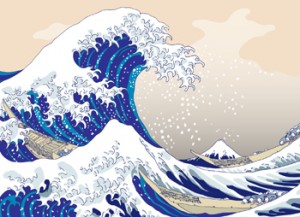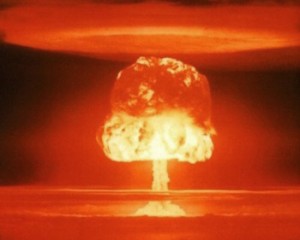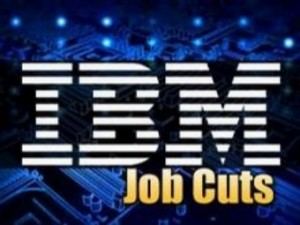 I was 11 when I read The Big Wave
I was 11 when I read The Big Wave by Pearl S. Buck. I still remember my confusion and horror at the end of the book. How could Jiya move back to the same fishing village where his family died in a tsunami? Not only did he return with his new wife but they built a house with doors that opened wide to the ocean.
Some people find it odd that I was risk-averse as a child – a time of life when vulnerability is incomprehensible. They think that because I gave up a good corporate gig, went back to graduate school when I was older than many of my professors, play poker and have mid-six figures riding in the market each day that I welcome risk now. I don’t. I just want my risk to be overt. I can’t control my enemy but — at this point in my life — I need to be able to look him in the eye.
There is no risk-free rate of return. Black-Scholes, diversification, VaR and Bayesian statistics won’t protect me in the market any more than a sea wall protected the Japanese or the levees worked in New Orleans.
To some extent, we have all built houses on the shore. Most people just don’t know it. Or like me, when I graduated college, they think they can control risk.
My Personal Safety Myth
On March 28, 1979 there was a partial core meltdown in Unit 2 of the Three Mile Island Nuclear Generating Station. A month later, Westinghouse nuclear division couldn’t wait to get their hands on me. Needless to say, college recruiting had been an uphill battle for companies that had anything to do with nukes that year. I turned Westinghouse down.
( Risk-related aside: A few months later, I found myself having dinner at the Pakistani embassy in Paris. I remember the ambassador thought it risky to serve wine with dinner. There was much debate about the potential backlash should news leak that alcohol was on the premises.
Risk-related aside: A few months later, I found myself having dinner at the Pakistani embassy in Paris. I remember the ambassador thought it risky to serve wine with dinner. There was much debate about the potential backlash should news leak that alcohol was on the premises.
In hindsight, this was an odd risk to sweat. After dinner we young folk were excused so that the Under Secretary General of the United Nations, the French ambassador and the Pakistani ambassador could discuss Pakistan’s aspirations for nuclear technology.)
I didn’t take the job at General Foods’ Maxwell House coffee division. I would have been the only woman engineer at the Hoboken plant. In fact, I would have been the first woman, save its secretarial workforce, hired there. Too risky. The plant had also just come off strike. Also risky. And besides, when I told my father about the offer, he said, “Coffee. Making fucking coffee? After four years at Columbia? You’d be better off peddling your ass on the street.” My father always had a way with words.
Instead, I took what I believed to be the riskless choice. Tom Watson Sr. recognized the economic tragedy and indignity associated with laying off workers. As such, IBM had a full employment policy. It had a defined pension plan and health benefits that rivaled those afforded members of Congress.
 By the time IBM’s tsunami warning came, I was a middle-manager with a group of 60+ managers, engineers and technicians. A source told me IBM was preparing to layoff tens of thousands of employees. The Mid-Hudson Valley, home of the mainframe and where I worked, would be hardest hit. I immediately transferred to Austin and sold my house to IBM – one of the last to be offered that perk.
By the time IBM’s tsunami warning came, I was a middle-manager with a group of 60+ managers, engineers and technicians. A source told me IBM was preparing to layoff tens of thousands of employees. The Mid-Hudson Valley, home of the mainframe and where I worked, would be hardest hit. I immediately transferred to Austin and sold my house to IBM – one of the last to be offered that perk.
At its peak, the Mid-Hudson Valley had 45,000 employees. Today, the number stands at fewer than 10,000. IBM owned my house for a year and a half before it could sell it for $50K less than they paid me.
I made it to higher ground but the experience changed me.
I got my undergraduate degree in Chemical Engineering, in part because a high-paying job was almost assured. I left IBM Austin three years after my transfer to pursue a graduate degree that held no such promise. I was there purely to learn more about risk – economic, financial, statistical and political.
The Risk Devils We Know
In almost sad irony, Japan hoped its involvement in World War II would result in greater access to the world’s oil and gas reserves. Instead, the country ended up embracing nuclear energy — despite Japan’s historically unique position to understand the technology’s more destructive powers.
But maybe we’re all a little like Japan – naturally gravitating to the risk devils we know. We delude ourselves into believing we can understand or control familiar risk better than unfamiliar risk. But there are ample examples to the contrary – that in fact comfort may beget arrogance or carelessness. For instance, investment “experts” mispriced or grossly underestimated risk, precipitating or exacerbating almost every market crash.
 1987’s Black Monday fall was made worse by the attempted use of portfolio insurance – a technique expressly designed to reduce risk in down markets. The experts, however, failed to realize that in a crash, there was no market to sell the very futures contracts designed to save them. In the end, the attempted use of portfolio insurance fueled the market’s downward spiral.
1987’s Black Monday fall was made worse by the attempted use of portfolio insurance – a technique expressly designed to reduce risk in down markets. The experts, however, failed to realize that in a crash, there was no market to sell the very futures contracts designed to save them. In the end, the attempted use of portfolio insurance fueled the market’s downward spiral.
Buck may have meant The Big Wave as a life-affirming metaphor. It isn’t. It is merely acceptance. I find it as horrific a concept now as I did when I was 11. But all that I have learned about risk assures me that there is no way to avoid its tenacious waters. You are always dancing with the devil — strange or familiar.
So like Jiya, I’ve built a house that will afford me a better view of the wave that will take me.
Recommended reading about market risk:
Fooled by Randomness: The Hidden Role of Chance in Life and in the Markets
5 Comments